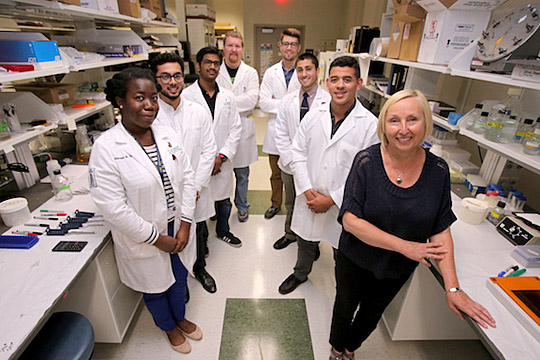Researchers from The University of Toledo, in collaboration with chemists from the Scripps Research Institute, have discovered a compound that normalizes glucose levels while increasing the mass and quality of bone.
Body processes that regulate energy metabolism and bone mass are closely intertwined, and numerous studies have shown individuals with Type 2 diabetes are at increased risk for bone fractures. Additionally, some current anti-diabetic drugs work well to regulate insulin levels, but can cause further bone damage.

Dr. Beata Lecka-Czernik, right, posed for a photo with her team, from left, Shermel Sherman, Faiz Tausif, Amit Chougule, Lance Stechschulte, Matthew Mazur, Zachary Rotter and Ali Eltatawy.
Targeting PPARγ, the protein in the body that regulates energy use and bone cell differentiation and function, Dr. Patrick Griffin and researchers from the Scripps Research Institute developed a series of new insulin sensitizers.
“Our multidisciplinary chemical biology team at Scripps Florida had spent many years developing precise structure activity relationships around many chemical scaffolds that alter the shape and behavior of PPARγ,” Griffin said. “These efforts were then combined with the bone biology expertise of Dr. Lecka-Czernik to explore whether we have compounds that maintain excellent insulin sensitization efficacy but are positive on bone health.”
Lecka-Czernik and her team at UT then tested these compounds for bone safety.
“During the course of our experiments, we discovered that a compound called SR10171 normalizes glucose levels in Type 2 diabetes, prevents associated weight gain, and increases the mass and quality of bone,” she said. “Remarkably, this experimental drug also maintains its positive effect on bone in non-diabetic conditions and acts as insulin sensitizer only on demand when normal glucose and insulin becomes imbalanced.”
SR10171 supports bone formation by directly regulating bone cells that work together to break down, build and protect bone.
The results also suggest the bone remodeling properties of this compound could be used to treat osteoporosis, Lecka-Czernik said.
The team’s findings, “PPARG Post-Translational Modifications Regulate Bone Formation and Bone Resorption,” was published in the August issue of EBioMedicine. This team science was funded in part on a collaborative grant from the National Institute of Diabetes and Digestive and Kidney Diseases.